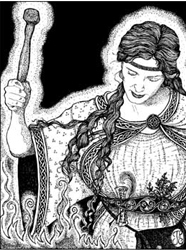Wheel of the Year Circle (3)
Launch gallery slideshow

| Swap Coordinator: | LadyT (contact) |
| Swap categories: | Themed |
| Number of people in swap: | 3 |
| Location: | International |
| Type: | None |
| Last day to signup/drop: | January 13, 2009 |
| Date items must be sent by: | January 20, 2009 |
| Number of swap partners: | 1 |
| Description: | |
|
The Earth, like all living things, has Her own rhythms and cycles. The changing seasons of the Wheel of the Year hold a foundational rhythm for life on planet Earth. The Wheel flows through an 8-point cycle: *stillness and anticipation of deep Winter * quickening and first stirring of Life * springing of Life * passionate flowering * ripening * ebb of the growing impulse * harvest * storing & preparation for Winter. 8 holidays (Sabbats) honor these sacred rhythms of the Wheel of Year. These sacred days are traditionally celebrated through sacred rites and festivals. When we celebrate these holidays, we join in partnership with the Earth, lending our energies to the turning of the Wheel. The cycle of these 8 stages of the Wheel of the Year are found again and again in the many rhythms of our lives: *in our journey from birth to death * in the process of any endeavor from start to finish *in the 8 phases of the waxing and waning moon *in the daily movement of the sun * in inhalation and exhalation of each breath By consciously tuning to the Wheel of the Year, we can tune deeply to this foundational cycle of life, and learn to work with the energies of Nature, rather than struggling against the natural currents of life on Mother Earth. This an ELECTRONIC & INTERNATIONAL SWAP - As each Sabbat occurs (eight times a year), you will email ME one (1) corresponding ritual that you have either written yourself or that you have participated in and like. I will then forward it to all of the swappers - for all to see, share and get ideas for their own practices. This is really about sharing ideas on how you live your spiritual life! You WILL be assigned one (1) swap partner - because its the way this system works - so please feel free to send that partner a little token, talisman or something for their altar that corresponds with your sent ritual - THIS WOULD CONSTITUTE a HEART but not necessary. So if you sign up for this SWAP - you must agree to not badly rate your partner if you DO NOT receive anything and by the same token - give them a heart for doing so. You will have to re-sign up for each Sabbat - as there is no way (that I know of) to re-assign partners (so it makes things exciting and everyone gets a cultural exchange) and dates for each one without starting over. I will make sure to send you an email inviting you each time. RULES (even though I hate them) Rating of 4.5 or better, with NO no sends in the past six months. Go ahead and message me if you’ve been rated unfairly at any point or have a good reason for your lower rating or the no sends, and we’ll talk. I’m certainly open to listening - as I understand LIFE HAPPENS! Newbies allowed, but with filled out profiles please by the time you are signing up. Communication is key. If you’re going to be late with the swap, let your partner know. If your partner tells you he/she is going to be late, and keeps up the communication, give him/her a break. Sometimes things come up that just can’t be helped. Life happens! I reserve the right to ban anyone that I think might be a problem. This means people that I've noticed have a history of rating unfairly, nastiness, etc. I believe in playing nice & fairly. ENJOY, Have FUN - after-all, this is a HOBBY . . hobbies are supposed to bring you joy & happiness!!!!!!!! The third position on our wheel is Imbolc . . .. Spring is Coming!: Imbolc is a holiday with a variety of names, depending on which culture and location you’re looking at. In the Irish Gaelic, it’s called Oimelc, which translates to “ewe’s milk.†It’s a precursor to the end of winter when the ewes are nursing their newly born lambs. Spring and the planting season are right around the corner. The Romans Celebrate: To the Romans, this time of year halfway between the Winter Solstice and the Spring Equinox was known as Lupercalia. For them, it was a purification ritual in which a goat was sacrificed and a scourge made of its hide. Thong-clad men ran through the city, whacking people with bits of hide. Those who were struck considered themselves fortunate indeed. This is one of the few Roman celebrations that is not associated with a particular temple or deity. Instead, it focuses on the founding of the city of Rome, by twins Romulus and Remus, who were suckled by a she-wolf -- in a cave known as the "Lupercale". The Feast of Nut: The ancient Egyptians celebrated this time of year as the Feast of Nut, whose birthday falls on February 2 (Gregorian calendar). According to the Book of the Dead, Nut was seen as a mother-figure to the sun god Ra, who at sunrise was known as Khepera and took the form of a scarab beetle. Christian Conversion of a Pagan Celebration: When Ireland converted to Christianity, it was hard to convince people to get rid of their old gods, so the church allowed them to worship the goddess Brighid as a saint -- thus the creation of St. Brigid's Day. Today, there are many churches around the world which bear her name. Purification and Light: For Christians, February 2nd continues to be celebrated as Candelmas, the feast of purification of the Virgin. By Jewish law, it took forty days after a birth for a woman to be cleansed following the birth of a son. Forty days after Christmas – the birth of Jesus – is February 2nd. Candles were blessed, there was much feasting to be had, and the drab days of February suddenly seemed a little brighter. Love & Courtship: February is known as a month when love begins anew, in part to to the widespread celebration of Valentine's Day. In some parts of Europe, there was a belief that February 14th was the day that birds and animals began their annual hunt for a mate. Valentine's Day is named for the Christian priest who defied Emperor Claudius II's edict banning young soldiers from marrying. In secret, Valentine "tied the knot" for many young couples. Eventually, he was captured and executed on Feb. 14, 269 C.E. Before his death, he smuggled a message to a girl he had befriended while imprisoned -- the first Valentine's Day card. A Celtic Connection: Serpents in the Spring Although Imbolc isn't even mentioned in non-Gaelic Celtic traditions, it's still a time rich in folklore and history. According to the Carmina Gadelica, the Celts celebrated an early version of Groundhog Day on Imbolc too – only with a serpent, singing this poem: Thig an nathair as an toll (The serpent will come from the hole) la donn Bride (on the brown day of Bride (Brighid) Ged robh tri traighean dh’an (though there may be three feet of snow) Air leachd an lair (On the surface of the ground.) Among agricultural societies, this time of year was marked by the preparation for the spring lambing, after which the ewes would lactate (hence the term "ewe's milk" as "Oimelc"). At Neolithic sites in Ireland, underground chambers align perfectly with the rising sun on Imbolc. The Goddess Brighid Like many Pagan holidays, Imbolc has a Celtic connection as well, although it wasn’t celebrated in non-Gaelic Celtic societies. The Irish goddess Brighid is the keeper of the sacred flame, the guardian of home and hearth. To honor her, purification and cleaning are a wonderful way to get ready for the coming of Spring. In addition to fire, she is a goddess connected to inspiration and creativity. Brighid is known as one of the Celtic "triune" goddesses -- meaning that she is one and three simultaneously. The early Celts celebrated a purification festival by honoring Brighid, or Brid, whose name meant "bright one." In some parts of the Scottish Highlands, Brighid was viewed as Cailleach Bheur, a woman with mystical powers who was older than the land itself. Brighid was also a warlike figure, Brigantia, in the Brigantes tribe near Yorkshire, England. The Christian St. Brigid was the daughter of a Pictish slave who was baptised by St. Patrick, and founded a community of nuns at Kildare, Ireland. In modern Wicca and Paganism, Brighid is viewed as the maiden aspect of the maiden/mother/crone cycle. She walks the earth on the eve of her day, and before going to bed each member of the household should leave a piece of clothing outside for Brighid to bless. Smoor your fire as the last thing you do that night, and rake the ashes smooth. When you get up in the morning, look for a mark on the ashes, a sign that Brighid has passed that way in the night or morning. The clothes are brought inside, and now have powers of healing and protection thanks to Brighid. | |
Discussion
Leave a Comment
You must be logged in to leave a comment. Click here to log in.
- Info:
- Home
- |
- About
- |
- Forum Rules
- |
- Terms of Use
- |
- Press
- |
- Advertising
- |
- Blog
- |
- Graphics & Stuff
- Help:
- New User Info
- |
- FAQ
- |
- Group Info
- |
- Glossary
- |
- Forums
- |
- |
- Contact Admin

